
We collect basic website visitor information on this website and store it in cookies. We also utilize Google Analytics to track page view information to assist us in improving our website.
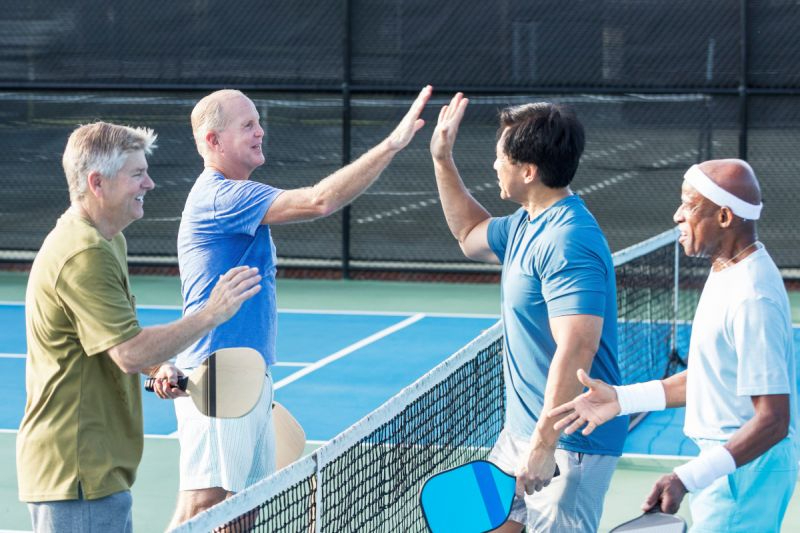
Pickleball has been the fastest-growing sport in North America for three years running, with a whopping 36.5 million players in the U.S. alone and a paddle market topping $150 million. And it's not just for kids and older folks—the biggest group of players is young adults aged 18 to 34.
But there's a catch: while there are almost 14,000 places to play in the U.S., the demand for indoor pickleball courts is still skyrocketing. Pickleball enthusiasts want to play year-round, rain or shine. That's where your facility comes in.
Finding the right indoor space for pickleball, however, can be a serious challenge. Ceiling height, floor surface, lighting—there's a lot to consider. But don't worry, we've got you covered.
In this blog post, we'll walk you through the basics of creating the perfect indoor pickleball facility, and why domes are the ultimate solution.
Pickleball's explosive growth means more people are grabbing their paddles and heading to the courts. But not just any space will do. Pickleball has some unique requirements, and finding the right space to play indoors can be a pickle (pun intended.)
Many pickleball spaces we see today didn’t start out that way—they’re often commercial spaces, former offices or stores, that took a lot of TLC to make that transformation.
While these repurposed buildings might seem like an easy, affordable fix, they often fall short in key areas.
Pickleball is a game of epic lobs and smashes, so you need enough overhead clearance to avoid hitting the ceiling. Low ceilings can cramp your game and even be dangerous.
A minimum ceiling height of 18-20 feet is okay, but more is even better. Unfortunately, most existing buildings weren't designed with pickleball in mind, so finding a space with enough vertical clearance can be a challenge.
Next, pickleball courts need a wide-open playing area. A single standard pickleball court size is 44 feet long and 20 feet wide. Obviously, you can’t have columns obstructing that area.
Columns on the periphery of the court are a problem as well, making the space feel cramped and creating safety hazards for players and observers.
Again, most existing buildings weren't designed with pickleball in mind, so finding that perfect, clear-span space can be tricky.
Lighting is also important. Nobody really wants to play pickleball in a dimly lit dungeon (pickleball fanatics may settle if it’s the only game in town, but if there’s brighter competition, that’s going to draw away customers.)
Whether it's natural sunlight or artificial lighting, it needs to be bright and evenly spread across the court. Glare and shadows can be real buzzkills, making it hard to track the ball and potentially leading to accidents.
And let’s face it: pickleball is a noisy sport. The constant pop-pop-pop of the ball hitting the paddle is music to some ears, but it can be a real racket for others, especially indoors, acoustics are worth considering. So, finding a space that can handle the unique acoustics of pickleball is crucial.
With pickleball's popularity soaring, the demand for indoor facilities is also through the roof. It's a smart business move to tap into this growing market and provide a space where people can play their favorite sport year-round, regardless of the weather.
But as we've seen, finding the perfect indoor pickleball location can be like searching for a needle in a haystack. Most existing buildings just weren't built with pickleball in mind. Low ceilings, pesky columns, and lack of soundproofing can stop your venture before it gets off the ground.
But don't worry! There's a solution that ticks all the boxes and then some for pickleball perfection.
Air-supported domes are the MVPs of the pickleball world, offering a unique combination of benefits that traditional indoor spaces simply can't match!
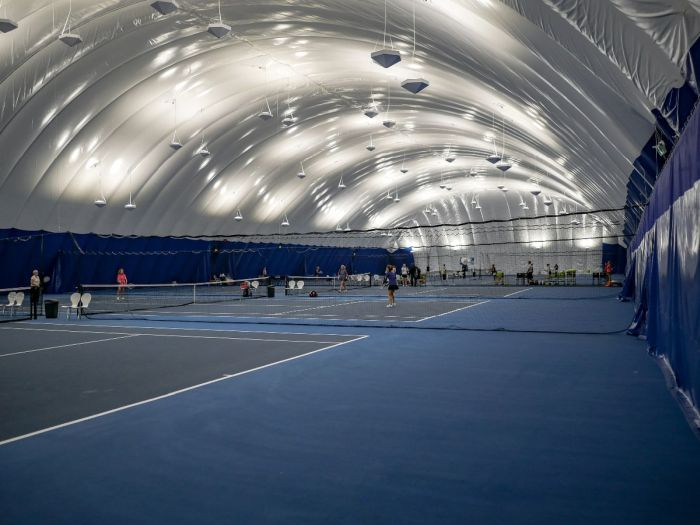
Sprawling courts at Marilyn Redvers Tennis in Aurora, Ontario
As we've seen, pickleball demands both ample ceiling height and a wide-open playing area. Air-supported domes meet those requirements and then some.
Domes have spacious, column-free interiors and soaring ceilings. You can easily fit multiple pickleball courts without worrying about obstructive columns or low-hanging beams getting in the way of your game. In fact, even our smallest domes (around 24,000 square feet) can fit around 30 pickleball courts—and our largest domes (+100,000 square feet) can fit over a hundred!
Maybe you don’t want to cram dozens and dozens of pickleballs courts under one roof. You don’t have to. It’s up to you how to use the space under your dome, and with optional dividers and netting, it’s very easy to do.
For example, the Cougar Dome hosts six full-size tennis courts (which is space for 24 pickleball courts!) as well as a synthetic turf surface for field sports, long and triple jump pits, a running track, and a 10-bay golf range. Multi-sport domes are incredibly versatile!
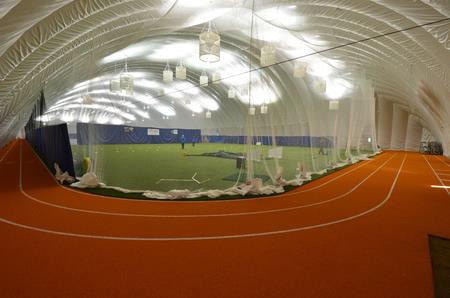
Running track separated by netting at The Cougar Dome in Truro, Nova Scotia
Plus, with ceilings typically reaching 30 feet or higher, you'll have plenty of room for those sky-high lobs and overhead smashes.
The beauty of domes is that they're completely customizable. You can design a pickleball facility from scratch, tailoring the layout and size to your specific needs and preferences. No more settling for cramped, converted spaces with awkward columns or low ceilings.
The constant pop-pop-pop of the ball hitting the paddle can get amplified in traditional indoor spaces, thanks to hard surfaces and lower ceilings. It's like playing in an echo chamber!
Air-supported domes, on the other hand, are designed to keep the noise down. Their fabric material absorbs sound, and the high ceilings help dissipate it, creating a much quieter environment for everyone. Some dome owners even install carpet for an extra layer of soundproofing.
Don't just take our word for it. Pickleball facility owners interviewed by Forbes have noticed that players stick around longer and spend more money when the noise is under control, and one owner with multiple facilities says the location with the fewest noise complaints is a converted tennis bubble!
A quieter court is a happier court, and happy players are good for business.
We mentioned how many indoor pickleball facilities are converted from existing buildings like old warehouses or retail spaces (you’ve probably encountered one yourself.) These spaces often lack natural light and can feel a bit like playing in a dungeon.
Air-supported domes, on the other hand, let the sunshine in! Domes can be designed with special translucent fabric panels that allow natural light to filter through, creating a bright and welcoming atmosphere for players. The Whitby Iroquois Soccer Club and Richmond Green Sports Centre are great examples.
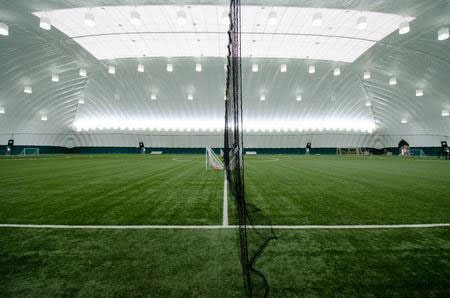
And for those cloudy days or evening games, domes are equipped with top-notch LED lighting systems designed specifically for sports, so you can always see the ball clearly and enjoy a comfortable playing experience day or night.
But let's not forget that the pickleball craze isn't just about fun and games. It's also a booming business. It's important to consider the revenue-generating potential of your pickleball facility, too—and that’s another area where domes come in clutch.
One of the biggest advantages of a dome for pickleball is its potential to bring in serious revenue. Domes aren't just for pickleball. They're versatile spaces that can host a whole range of activities—adding the potential for multiple revenue streams beyond pickleball memberships.
This could include additional sports like tennis or basketball, or even non-sporting events such as trade shows, movie nights, parties, or youth group activities. By diversifying what you offer, you can attract a wider audience and keep the revenue flowing.
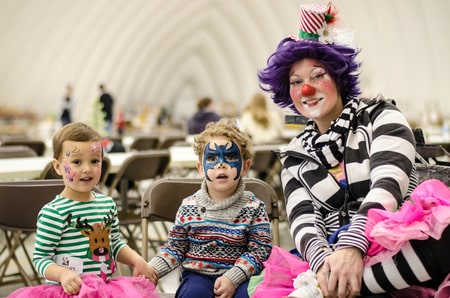
Holiday fun under our manufacturing dome (yes, we made all these domes under a dome of our own!)
Dividers or netting can easily section off areas within the dome, allowing for simultaneous activities without worrying about stray pickleballs. Have a slow season or off-peak hours? Rent out unused space to other groups for activities or events, maximizing your dome's earning potential.
Looking to create a social hub for pickleball enthusiasts? Some of our domes are designed with attached clubhouses, pro shops, or even restaurants. Others offer refreshments right under the dome itself.
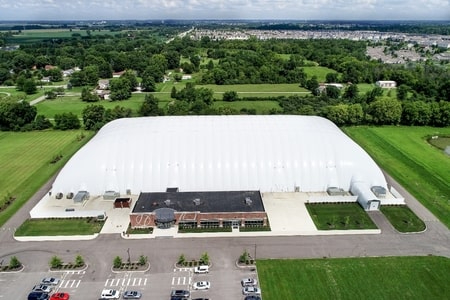
Reception area, change rooms, and pro shop attached to Bo Jackson’s Elite Sports in Hilliard, Ohio
Either way, providing food and beverages creates a welcoming atmosphere where players can relax and socialize, boosting customer satisfaction and your bottom line.
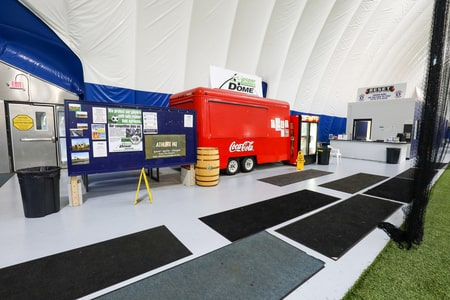
Now, let's talk about money. Building a brand-new dome might sound like a big investment, but it's often more cost-effective than trying to retrofit an existing building. Plus, you get a space that's tailor-made for pickleball!
But if you're looking for an even more budget-friendly option, consider converting an existing tennis bubble or adding pickleballs lines to existing tennis courts. Check out our blog post on how tennis clubs are retrofitting their courts to bring in pickleball players without pushing away their core tennis customers.
It's a win-win: you save on construction costs and give new life to an underutilized space.
The pickleball craze isn't slowing down, and now is the perfect time to capitalize on this growing sport. Don't let the challenges of finding the ideal indoor space hold you back! Air-supported domes offer a winning combination of space, comfort, and revenue-generating potential.
Contact The Farley Group today and let our experts guide you through the process of building the pickleball dome of your dreams.

How many times have you frantically checked (and re-checked) the forecast before a game, hoping the rain would hold off or the heatwave would break?
Today, managing outdoor sports is becoming more and more like predicting the weather: a tricky and often unreliable task.
Climate change is forcing society to adapt, and sports are no exception. It’s time to talk about solutions.
Here’s why air-supported domes, like those from The Farley Group, can keep the game going even with extreme, unpredictable weather conditions.
As climate chaos becomes the new norm, sports leagues and businesses worldwide are grappling with the consequences. The rules of the game are evolving and bringing new challenges with them.
Take tennis, for instance. The sport demands prolonged exposure to scorching courts, leaving players vulnerable to heat-related illnesses as temperatures soar. The sweltering heat radiating off hard surfaces only compounds the issue, risking not just the well-being of players but also that of ball boys and girls and spectators.
With over 80% of tennis tournaments staged outdoors, sometimes with matches that stretch for hours, extreme heat poses an existential threat. Recognizing this danger, the US Open has implemented an extreme heat policy, allowing for breaks and match suspensions during temperature spikes.
Soccer has also felt the heat. You’ll remember that the 2022 FIFA World Cup in Qatar was rescheduled from its traditional June-July slot to November-December to avoid scorching summer temperatures that could jeopardize players and fans alike. It’d be nice to think that was just a Qatar problem, but it wasn't—local and multinational organizations alike, from Major League Soccer (MLS) to Alberta Soccer in Canada, have also had to set new safety thresholds to deal with hot weather events and pollution peaks.
Speaking of pollution, we can’t forget how many of us have had to cancel games because of the poor air quality caused by record-breaking wildfires across many parts of Canada and the United States. The shifting climate is a major contributor to wildfires being as bad (and as frequent) as they are.
The bottom line is that increasingly frequent extreme weather events are becoming the norm.
An analysis by Climate Central revealed a concerning trend: 198 US cities have experienced a surge in days with heat index temperatures of 90°F or higher over the past four decades.
Extremely rainy days have also become 18% more common since pre-industrial times, with projections indicating a potential 65% increase if global warming hits 2°C.
It’s not good news for those of us who are invested—not only financially, but as a way of life—in outdoor sports. And it demands a massive, strategic overhaul in how sports facilities are planned and managed.
What if you could take climate uncertainty out of the equation?
Imagine not having to cancel another game or reschedule an event because of weather woes.
This isn't just wishful thinking. With the right kind of setup, it's possible.
An air-supported dome is like a trusty umbrella that never fails. Here’s how our Farley domes (often called “bubbles” in the case of tennis domes) are safe spots for sports no matter what the sky throws down.
Imagine a giant, inflatable bubble that you can play sports inside. That's pretty much what Farley domes are, but with some extra tough skin.
Made from layers of strong, UV-resistant fabric, our domes can stand up to heavy winds, beating rain, extreme heat, and loads of snow without as much as a flinch. They're held down by heavy cables and a solid anchoring system that makes sure the dome stays put, even on super windy days. Rain or shine, the games go on.
The best part? Inside the dome, there are no poles or beams in the way, so you’ve got all the space you need to kick, run, or swing without bumping into anything. It’s a completely clear-span structure.
Inside of a dome, the temperature and humidity are always just right. Thanks to advanced climate control systems, the temperature and humidity inside our domes are maintained at optimal levels for athletic performance and spectator comfort.
On a hot, humid day, the air inside the dome is cool and fresh, creating a comfy oasis from the sweltering heat. During colder months, the dome is warm and inviting, shielding you from the biting cold outside.
We know athletes perform at their best when conditions are consistent. The controlled climate reduces the risk of heat-related stress and cold-induced injuries so that players can focus on the game without worrying about the weather. This consistent and comfortable environment is also better for spectators (soccer parents, that means you!)
For private clubs and businesses, the promise of a pleasant playing experience is also a massive competitive advantage. People are more likely to join (and actually attend) when they know they'll be playing in comfort, regardless of the weather conditions outside. This reliability can help you maintain and even grow your member base, increase rentals, and improve event participation.
Our domes have a smart ventilation system that keeps the air fresh and the temperature steady. Whether it's a hot, sticky day or a cool evening, the air inside the dome is just perfect for sports, ensuring that athletes and fans are comfortable, and the game is always on.
Seasonal domes are installed over outdoor courts or fields temporarily, usually in the fall or winter, and then taken down when the weather is favourable. Permanent domes, on the other hand, stay put all year long.
For clubs, municipalities, and academic institutions looking to weatherproof their outdoor spaces without sacrificing sunny days on the field, a seasonal dome is a practical, flexible solution.
Traditionally, most facilities with a seasonal dome would put it up in the fall and take down the dome come spring. This allows sports like soccer and tennis to continue indoors during the colder months, then resume outdoor play in the spring.
But if the weather is particularly unforgiving one year—say, you’re deluged with buckets of spring showers just won’t end—you can leave the dome up well into the summer.
However, if you’re faced with a sweltering summer, you can put up the dome in the middle of the summer to give players relief.
The point is, with a seasonal dome, you don’t have to ‘commit’ to converting outdoor facilities to indoor ones. You have the freedom to decide for yourself when it’s time to change course.
Of course, for areas or sports that require year-round consistency, permanent domes are the answer. These structures remain up all year, providing a consistent venue that doesn't depend on the weather.
Debating between a permanent dome and a seasonal dome? Get in touch. We’ll help you figure out which kind of dome is right for you.
There’s no denying that climate is changing the way we plan and play outdoor sports. From extreme heat and poor air quality to unexpected rainfalls and cold snaps, the challenges are real, and they're here now.
But these challenges don't have to mean game over for your sports events.
Air-supported domes offer a robust, smart solution that keeps the weather out and the games going.
Domes not only protect against rain, sun, snow, and pollution at only a small fraction of the cost of traditional, brick-and-mortar indoor sports facilities. They're quick to install over existing fields and courts, providing an affordable way to transform outdoor venues into year-round facilities. And with powerful air exchange systems, Farley domes provide a controlled, healthy environment that lets athletes perform at their best and spectators relax, no matter the season.
We encourage you to explore more about how The Farley Group’s domes can benefit your sports programs and events. Whether you're looking to upgrade existing facilities or build new ones, consider how a Farley dome could be your next game-winning strategy. Contact us to find out how you can turn your sports venue into a weatherproof, year-round destination for athletes and fans alike.

As the weather turns colder and the days shorter, sports lovers grapple with unpredictable weather conditions. The transition from fall to winter can be challenging, not just for athletes and coaches, but also for facility owners, as it impacts the continuity of all kinds of outdoor sports: soccer, tennis, golf, track and field, and other field sports.
However, there's a practical solution to this dilemma: air-supported domes. These domes are a game-changer for seasonal sports. They extend the momentum of summer activities into the fall and seamlessly carry it through the winter's chill.
Under a Farley Dome, athletes can train and compete in comfortable, consistent conditions, regardless of the weather outside. Essentially, domes bridge the gap between fall and winter sports, turning a once challenging period into a seamless, year-round sports experience.
In this blog post, we will talk about the many ways that air-supported domes not only benefit facility operators but also athletes and the broader sports community during the fall-to-winter transition.
The Farley Group has been manufacturing, installing, and servicing sports domes around the world for more than 50 years. Ever since our founder, Ralph Farley, introduced air-supported domes to North America, The Farley Group has led the industry with our commitment to quality and integrity. Our team consists of sales consultants, designers, and highly skilled production and service professionals skilled in all aspects of air structure technology. We’d love to talk to you about your dome project.
Call us or send us a message to get started now!
In Canada and the States, where the weather shifts from mild to harsh unpredictably, transitioning between seasons poses a significant challenge for sports continuity. Sports popular in the summer months often come to a halt in the winter, especially in communities lacking affordable indoor sports facilities.
Warm-weather sports like soccer, tennis, and golf really feel the impact when seasons change. Air-supported domes, however, make transitioning from fall to winter in these sports effortlessly smooth.
The excitement of a soccer game on a crisp fall day can quickly diminish with unpredictable weather. Rain, snow, and cold not only dampen spirits but also disrupt schedules, rendering fields unusable and hazardous. What were once lush, green fields become muddy or icy, increasing injury risks and diminishing the quality of play.
Plus, shorter days limit practice and game time, forcing players and coaches to squeeze in activities before nightfall.
Example: Afrim's Sports is the place to be when it comes to indoor soccer in the Albany, New York area! Located at the home of the Bethlehem Soccer Club, this Farley Dome covers nearly 44,000 square feet of indoor turf.
Tennis courts also suffer from seasonal changes. Damage from moisture, cold, and freeze-thaw cycles compromises playing surfaces, making them unsafe and hindering the play experience.
Cold temperatures also affect players and their equipment, with every drop in temperature impacting comfort and performance.
Without indoor alternatives, players lose valuable practice time essential for skill development and competitive edge.
Example: Barrie North Winter Tennis, a division of Tennis Clubs of Canada, is located in Midhurst, Ontario, and consists of 4 tennis courts under a heated, air-supported Farley dome complete with new LED lighting. The Farley Dome is erected in early October, and is taken down at the end of April each year.
Golfers face challenges as driving ranges become less inviting in colder, wetter conditions.
Practicing swings and techniques is harder, and golf gear, like balls, performs differently in the cold, affecting gameplay. This drop in comfort and accessibility leads to reduced player turnout.
Example: The Hastings Fieldhouse Farley Dome features a walking track, soccer field, golf driving range, as well as courts for basketball, ball hockey, and racquet sports. It truly is a multi-functional facility. It includes the capacity to accommodate many varied and unique training activities, as well as clinics and workshops.
Winter poses major challenges for track and field athletes. Outdoor tracks, essential for training, become unusable due to snow and ice. Each event, with its specific training requirements, is disrupted, affecting preparation and performance.
The cold weather also increases the risk of muscle strains and injuries, as proper warm-up becomes more difficult and slippery conditions pose additional hazards.
Example: The Farley Dome at University of Alberta's Foote Field is the largest, air-supported dome structure in all of Alberta, turning the seasonal field into a year-long training facility. It includes a multi-lane, 140 meter track with a jump pit available to the track and field community of Edmonton.
Each year, facility owners and operators face the challenging transition from fall to winter sports. This is where air-supported domes, particularly Farley Domes, come into play. Our domes are designed to help make manging sports facilities straightforward and efficient, regardless of the season.
One of the standout features of our domes is their rapid setup. They can be erected in just a day or two, minimizing downtime and keeping the sports schedule on track. This speed is a lifesaver for places that need to switch from open-air to indoor settings quickly when the weather changes.
Timing is everything here. Facility owners can time the dome set-up right at the end of the fall season. This means no awkward gaps — just smooth sailing from outdoor to indoor sports. It's this kind of scheduling smarts that helps get the most out of facilities all year round.
The ability to control the climate inside these domes is a significant advantage. Owners can dial in the perfect temperature, making it comfy for both players and fans. This matters a lot when you're moving from the mild fall to the chilly winter.
Stable conditions are key for sports where the weather really affects the game. Domes keep things consistent, offering the best setting for sports, come rain or shine.
Energy efficiency is another big plus. These domes use smart heating and cooling, keeping costs down, especially in the colder months when heating bills can go through the roof.
Domes are champs at handling sudden weather shifts. They can warm up or cool down in no time, crucial for dealing with those unpredictable fall and early winter days. This means the facility stays open and comfy, no matter what Mother Nature throws at it.
These domes also extend playtime. As days get shorter and colder, indoor domes offer a bright, warm spot for evening and night games.
And let's not forget how well they protect against the elements. Wind, rain, snow — domes keep them all out. This means less weather delays and more reliable schedules for teams and facility owners.
With their quick setup, climate control, and weather readiness, they're the perfect choice for facility owners wanting to keep the game going all year long. Choosing a dome isn't just prepping for winter; it's opting for non-stop sports, no matter the season.
For sports facility managers wrestling with tough decisions, choosing air-supported domes is a no-brainer. It's a move toward keeping the action going and growing. Think of it as an investment that pays off in more ways than one!
Why let the weather dictate another season? Now's the chance to turn your sports facility into a year-round hub of excitement.
We've all been there — the nail-biting worry of whether an early frost or a sudden downpour will throw the day's schedule into chaos.
For outdoor sports clubs and businesses, the fall and winter seasons usually means cancelled events, disappointed customers, and yes, a dip in revenue that lasts well into spring.
But it doesn’t have to.
Stay with us as we explore the various ways that a dome helps you turn fall and winter from a stressful slump into one of the best seasons of the year.
Unlock the potential of your sports facility. Contact The Farley Group to understand the opportunities a dome offers.
When you think of indoor sports, you might imagine gymnasiums built from brick and mortar or steel and concrete. But in the world of sports facility solutions, there's something much more futuristic: the air-supported dome.

Domes are a marvel of modern engineering. Essentially, a dome is a large "bubble" made of durable, weather-resistant fabrics. This fabric is held up, not by beams or columns, but by a steady stream of air pressure. The result? A vast, open space free from annoying columns or beams, perfect for soccer, tennis, golf, and virtually any other sport you can imagine.
More importantly, air-supported domes are a fortress against bad weather. Whether it's rain, high winds or snow, sports that would normally have to be cancelled can continue smoothly under the protection of a dome.
Plus, their unique construction and flexibility makes domes an incredibly cost-efficient solution. Think of how much steel, brick, and concrete it takes to build an indoor soccer field or driving range — a dome offers the same benefits at a fraction of the cost.
Fall and winter, traditionally seen as downtime for outdoor sports facilities, can become your peak seasons with the right approach. An air-supported sports dome not only shields your space from the whims of weather but offers numerous avenues to scale up, diversify, and unlock untapped revenue streams.
Let's dive into the specifics.
We've all felt the sting of the off-season. Watching a perfectly good field or court sit underutilized, waiting for the next season to roll around… it feels like a missed opportunity.
With a dome, the action doesn't have to stop. Our sports domes feature state-of-the-art climate control to maintain a comfortable temperature and humidity inside even as mercury plummets. As far as snow and rain are concerned? They might as well not exist.
This means that the players, clubs, and sports organizations who book your facility in the warmer months can continue to practice and play into October, November, December...all the way around to next spring, when the dome’s ready to come down until next fall. No gaps.
Think about it – leagues can run longer, training sessions can be more frequent, and events don't have to be crammed into the summer months. To give just a few examples:
* Soccer Training Camps:
* Tennis Tournaments:
* Golf Driving Range:
All these result in higher player satisfaction, as they get more time to hone their skills and engage in the sports they love.
And for you? A significant uptick in revenue, even when the trees are shedding their leaves.
Don’t let the cold keep you down. Extend your sports season and revenue with The Farley Group’s domes.

Have you ever found yourself looking at your facility and thinking, "I wish I could do more with this space"? With an air-supported dome, you can!
Every business owner knows the unease of relying solely on one kind of activity or event, especially when unforeseen circumstances can throw a wrench in the plans. The unpredictable nature of weather or seasons can easily affect bookings, causing revenue to fluctuate.
This is the beauty of a dome. Domes aren’t just for sports – they’re incredibly versatile spaces you can easily adapt to accommodate a wide array of activities and events.
Picture hosting fitness classes, from yoga to Zumba. Imagine setting up exhibitions, trade shows, or craft fairs. How about community events, workshops, or even theatrical performances? These are just a few ideas to tap into new customer segments and diversify your revenue.
And the beauty of it? No rain checks. With a dome, you're not just playing the game – you're changing it!
Think about the number of times you've had to cancel or reschedule games or events due to weather. The lost revenue, the disappointment of your clients…it’s beyond frustrating.
For many sports facility owners and managers, the looming threat of bad weather is a constant source of stress. It’s not just about the money, but about maintaining customer satisfaction.
And this isn’t just a fall and winter problem, either. Spring showers and summer storms are just as disruptive.
The great thing about domes is that they don’t have to go up each fall and come down each spring. Permanent domes that stay up year-round are a fantastic option for those who are looking to create true revenue stability.
In a world full of uncertainty (especially when it comes to weather), your dome brings a level of predictability and consistency that both you and your clients will love. Weatherproof your facility with The Farley Group. Learn more about our year-round dome solutions.

A Farley dome can be your secret weapon to unlock the full revenue potential of the fall and winter seasons. Domes provide a dependable, weather-proof, and customizable environment that transforms outdoor spaces into year-round venues.
Interested in taking the leap or just want more details? Reach out to The Farley Group for more information about our sports domes. Our team is eager to assist and guide you toward a future where your facility stands out, rain or shine!

Pickleball: it’s like table tennis without the table. Or, you could say it’s like ping-pong on a tennis court.
However you put it, pickleball is one of the single fastest-growing sports in the world right now. And believe it or not, this is very, very good news for tennis clubs.
In cities across North America, where the demand for pickleball courts has outpaced the infrastructure, tennis clubs are cashing in ‒ just by adding pickleball lines to their existing tennis courts.
Just ask your local court contractor. These days, there’s a good chance they’re spending more time painting pickleball lines than tennis lines!
The market for pickleball just keeps growing. More than 3.3 million Americans played pickleball last year, a 10% increase in three short years. The sport made headlines last summer when it became a viral sensation in the Disney World NBA Bubble.
There’s even a group pushing for pickleball to become an Olympic sport, which could fuel an even greater explosion of interest.
Now, don’t get us wrong: tennis is here to stay. Not even a gold medal could turn pickleball into a replacement for good, old-fashioned tennis.
But for tennis clubs looking to shore up membership revenue ‒ especially in the wake of pandemic lockdowns ‒ bringing in pickleball could be the answer. And you don’t have to sacrifice a single tennis court to make it happen!
Let’s take a closer look at the surprising courtship between tennis and pickleball.
1. Background: What is Pickleball?
2. Pickleball vs. Tennis: What are the Differences?
3. 3 Ways to Add Pickleball Lines to a Tennis Court
Pickleball is a court game that combines elements of tennis and table tennis/ping pong: players at opposite ends of a court, a plastic ball, paddles, and a net. It can be played in singles or doubles.
The popularity of pickleball is usually attributed to its beginner-friendliness. It’s a simple, low-impact sport that new players can pick up the game in an afternoon. Pickleball is especially popular with the “cocktail crowd”: active adults over 55, who have the free time to play in peak and off-peak hours.
But don’t be fooled by its simplicity. Pickleball veterans bat a serious game! Where beginners usually hit the ball back and forth 15 to 20 times on a point, the pros can go for 90 or more.

While the two sports have plenty in common, the differences matter when it comes to planning a court.
A tennis court is 78 feet long and 36 feet wide. A pickleball court is much smaller at 44 feet long by 20 feet wide. In tennis, the net is set to a height of 43 inches at the ends and 36 inches at the centre; a pickleball net, on the other hand, should be 36 inches high at the ends and 34 inches in the centre.
Beyond the courts, the differences between tennis and pickleball are obvious. Pickleball is played with a plastic, perforated ball (called a pickleball) and paddle, rather than a tennis ball and racquet. The two sports also have different rulesets.
Now, the uninitiated might be tempted to view tennis and pickleball at odds, but that couldn’t be further from the truth. In fact, some of pickleball’s biggest advocates are current and former tennis players.
Pickleball is a popular “step-down” sport for tennis aficionados who need a change of pace. Many pickleball greats are former tennis players who transitioned to the lower-impact sport later in life.
Despite their differences, tennis and pickleball can easily coexist at the same club ‒ sometimes even on the same courts. With a bit of good planning, tennis clubs can leverage this to redouble their membership revenue.
Here’s the best part: you don’t have to tear up your existing tennis courts to bring in pickleball.
While replacement is always an option, adding pickleball lines to an existing tennis court lets the two sports coexist and gives club management an inexpensive way to gauge interest in pickleball.
Just keep in mind that for sanctioned tennis play, the rules only allow for tennis lines to appear on courts. So, unless you’re prepared to go all-in on pickleball, you’ll want to save your prime courts for tennis tournaments!
There are two ways to add pickleball lines to an existing tennis court:
a. One pickleball court per tennis court
b. Two pickleball courts per tennis court

This arrangement utilizes the existing tennis net. Since a tennis net is two inches higher in the centre than a pickleball net, you will have to install tie-downs to lower the net to the correct height. There is a product called the Convert-a-Net designed for this purpose.

This arrangement allows for two pickleball matches to take place on one tennis court at once. However, it requires that you bring in portable pickleball nets.
Be mindful of the fact that pickleballs are lighter than tennis balls and thus more susceptible to the wind. Having pickleball courts this close together outdoors can lead to balls ending up in someone else’s court!
Truthfully, playing pickleball outdoors has all the challenges as outdoor tennis...especially in the colder months. But with the help of a dome, pickleball can become an all-season sport just as easily! Learn more about the benefits of a tennis dome.
Have the lines installed by an experienced contractor! Tape won’t do the trick. In addition to being unattractive, and almost always crooked, tape can bond with the playing surface over time, becoming impossible to remove without damaging the court.
To make it easier to tell the lines apart, pickleball lines on a tennis court should not be painted white. Pickleball lines should be painted narrower than tennis lines for the same reason.
Since a tennis court is longer than a pickleball court, you might want to install a temporary barrier so that pickleballs don’t have to be chased the full length of the court.
